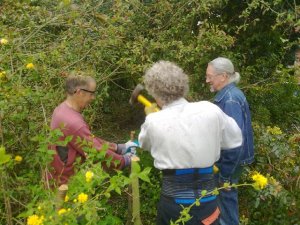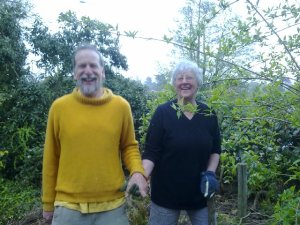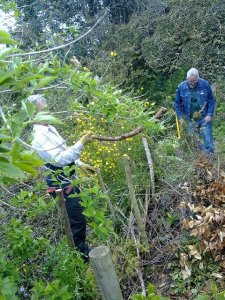 It just so happened that the five of us who turned up at Richard’s on Wednesday morning in Bungay to learn how to do dead-hedging with Paul were all over 50, and so the ad hoc name we came up with for that morning’s grouping was the NR35 Dead-Hedgers Society - the Over 50s Contingent!
It just so happened that the five of us who turned up at Richard’s on Wednesday morning in Bungay to learn how to do dead-hedging with Paul were all over 50, and so the ad hoc name we came up with for that morning’s grouping was the NR35 Dead-Hedgers Society - the Over 50s Contingent!However, anyone of any age was welcome to join the new Transition social enterprise, NR35 (NR = Natural Resources and NR35 is the local postcode) practical dead-hedge laying session.
This involved laying out and hammering in stakes staggered along a boundary of about twenty-five feet, and then placing and roughly weaving in branches and twigs from recently coppiced trees between the stakes. Making a hedge in this way would not only provide Richard with a decent boundary, but create a refuge for wildlife. Birds like wrens will often build their nests in dead hedges. Tony found an old nest rather larger than a wren’s, which we placed in the hedge once we’d finished.
This was the first time dead-hedging for all of us except Paul, who is a professional tree surgeon, and who taught us with consummate calm and patience. I asked everyone how it had been for them:
Cathy: Well, it uses up an amazing amount of material you might think would be difficult to dispose of. And it’s delightful doing it with others.
Nick: It’s hard work and it makes you sweat, but I’m surprised how easily we managed to get a good end-product (the hedge), in the space of 2 hours. And it’s brilliant we can go away and do it ourselves now.

Tony: Working as a team is really good fun. And it’s satisfying to start off with all this dead material and end up with a hedge.
I asked Paul how he found us as a group to teach: ”It’s been really satisfying. Everyone’s been very receptive and quick to learn the skills and techniques. The results speak for themselves: we have a very reasonable dead-hedge. I’ve seen a lot worse.”
 Me: I found the whole morning instructive and really good fun. I noticed that being physically engaged in building the dead hedge you got into a kind of rhythm with everyone- I would find my hands often knew just what to do. It would have taken forever to do it from a book.
Me: I found the whole morning instructive and really good fun. I noticed that being physically engaged in building the dead hedge you got into a kind of rhythm with everyone- I would find my hands often knew just what to do. It would have taken forever to do it from a book.Part of dead-hedging is jumping up and down on top of the laid branches when they’re at a certain height. Cathy and I held hands and pogo-ed up and down together. Later, I realised that over the years I’ve frequently bounced up and down at our events!
Just because you’re over 50 doesn’t mean you’ve got no bounce! Or that you can’t learn a new practical skill in the course of a morning in a congenial atmosphere with fellow reskilling dead-hedgers.

For more information on Sustainable Bungay’s NR35 Natural Resources group, see here.
All images by Mark Watson: Hammering in the staggered stakes; building the hedge from the bottom up; bird’s nest; receptive and quick to learn; the finished dead-hedge; bouncing up and down on the hedge
Originally posted on Sustainable Bungay's website 10th May 2013









No comments:
Post a Comment